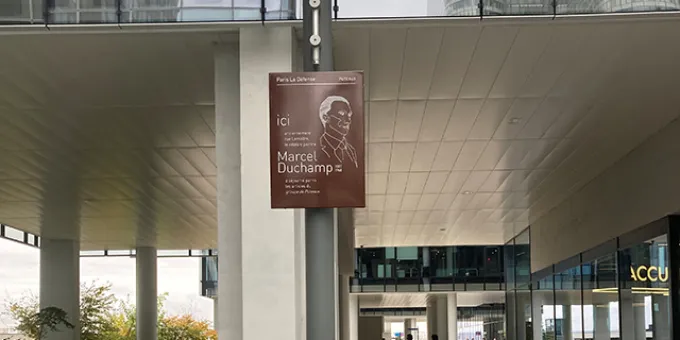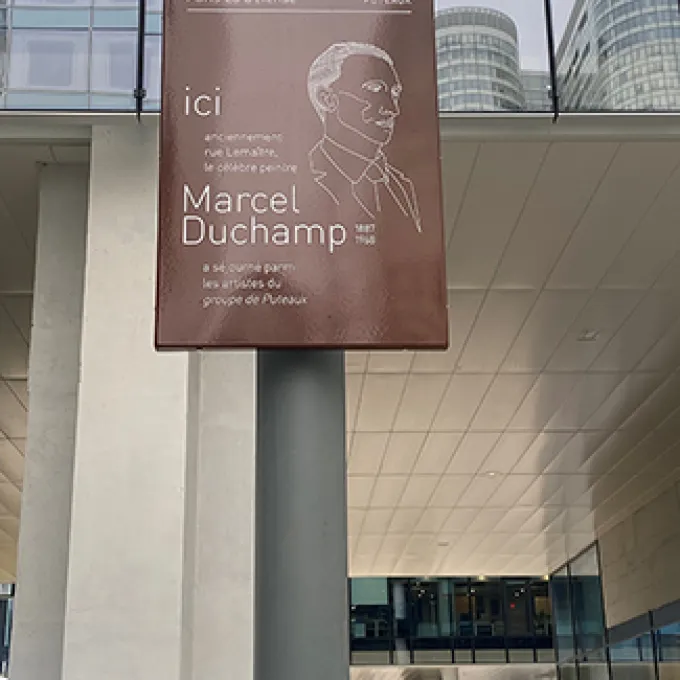
Unveiling of the Marcel Duchamp plaque in the Villon neighborhood
On Wednesday, October 29, 2025, a commemorative plaque honoring the painter Marcel Duchamp was unveiled on Place de la Pyramide, the very spot where a collective of artists known as the “Groupe de Puteaux” used to meet over a century ago.
Whether you are a regular visitor or just passing through Paris La Défense, it is sometimes hard to imagine what might have happened in the very place where you are walking a century ago... and yet! If you walk through the Villon district in Puteaux, you are probably following in the footsteps of a group of major artists of the Cubist movement, to which Marcel Duchamp belonged for several years.
Commemorating an artist

Art reigns supreme in Paris La Défense. While all styles, movements, colors, and artists are showcased in this open-air museum, this time it is Marcel Duchamp who is being honored. Wednesday, October 29, 2025, is a key date for the city of Puteaux, and more specifically for the Villon neighborhood, which has just unveiled a commemorative plaque in tribute to the man many consider to be the father of contemporary art. This plaque now adorns the Place de la Pyramide, on the very spot where the famous “Groupe de Puteaux” once met.
The artist who gets people talking

Marcel Duchamp was born in Rouen in 1887 into a family of artists. His attraction to art became apparent at a very young age, and he moved to Paris in 1904 to try to enroll at the Beaux-Arts, where he failed the entrance exam. He experimented with different artistic styles until he found his niche in Cubism, which enabled him to join the “Groupe de Puteaux” in 1910 alongside Jacques Villon, André Salmon, Guillaume Apollinaire, Maurice Princet, and others. His art evolved and the artist distanced himself from the collective of artists, moving increasingly towards a mixture of Dadaism and Surrealism. Marcel Duchamp died in 1968 and is now considered by many to be the father of contemporary art.
His major works are varied. In 1912, the painting Nu descendant un escalier (Nude Descending a Staircase) caused division among his Cubist peers. But he is better known for other types of works, such as Roue de bicyclette (Bicycle Wheel), which he designed in 1913. This ready-made, the original of which no longer exists, is marked by his penchant for Dadaism. The same is true of Fountain, which made a lasting impression when it was created in 1917. This urinal, diverted from its original function, is one of the most controversial works of its time. For some historians, this work marks the beginning of contemporary art.
Paris La Défense, an open-air museum

This commemorative plaque is a fitting addition to the cultural heritage of the business district, a mecca for contemporary art since its creation... Indeed, the area is home to more than 60 works of art, accessible in public spaces, free of charge! Some of these works are the brainchild of famous artists such as Calder, Miró, Cesar, and Moretti. Every street, every square, and every neighborhood is home to a mural, a sculpture, or a fountain that blends perfectly into the landscape of La Défense.
But the La Défense district is not limited to any particular style of artwork. The contemporary artworks, each one unique, are hidden away in different neighborhoods, making La Défense a unique destination for art, culture, and tourism, which can be explored through several themed tours.
See all the works in the permanent collection
Find out more about everything the neighborhood has to offer tourists



